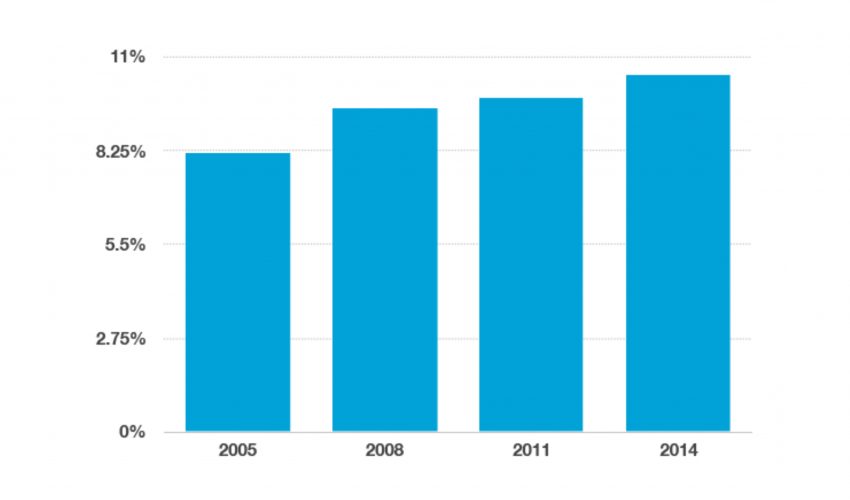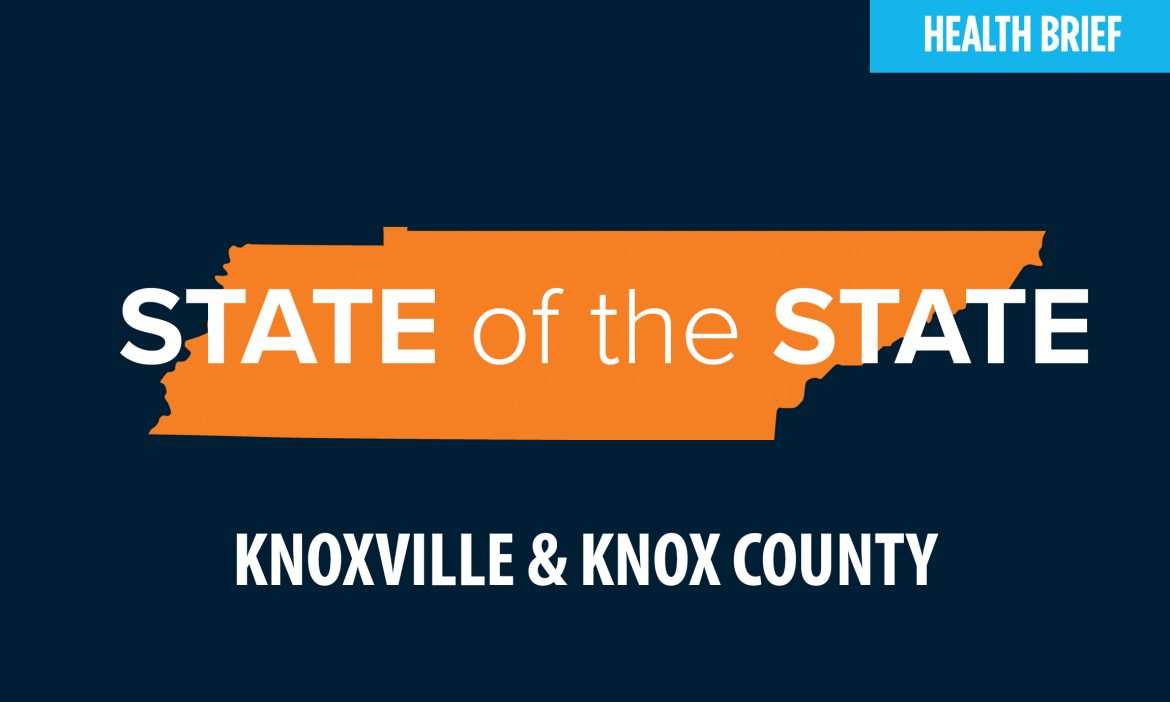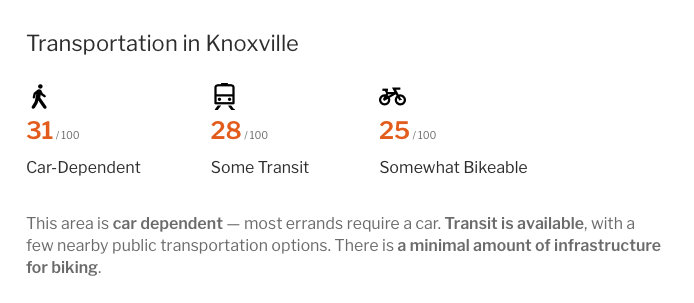Updated January 15, 2018
County health briefs offer comprehensive information about Tennessee cities and their surrounding areas. Each county health brief is different and focuses on that county’s biggest health challenges as identified by county and city health departments. Due to the highly customized nature of this information, statistics and metrics will vary from brief to brief.
The Knox County health brief focuses on the top health priorities as identified by local experts, including representatives from the Knox County Health Department.
Scroll down to read about health in Knox County, view sources or jump to a specific section:
What are the demographics of Knox County?
Population
448,164
Income
The median income in Knox County is $52,174, which is
- Higher than Tennessee’s ($48,506) and
- Lower than the U.S. ($59,039)
Age
The median age in Knox County is 37.

Sex
Female: 51%
Male: 49%
Race
White: 83%
Black: 9%
Hispanic: 4%
Asian: 2%
Multiple: 2%
Nearly 6% of Knoxville’s population was not born in the U.S, which is higher than Tennessee’s rate of 5% foreign-born residents.
Life expectancy
79 years for women
74 years for men
Those numbers are:
- Comparable to Tennessee’s life expectancy but
- Below the life expectancy for the U.S. as a whole
- 81 years for women
- 77 for men
Health index
Knox County scores 0.930 in the BlueCross Health Index where 0.867 is less healthy and 0.970 is more healthy.
The index measures the impact of more than 200 common diseases and conditions on overall health and wellness by assigning each county in the United States a health metric between 0 and 1, designating the proportion of optimal health reached by the county’s population. For example, a measurement of 0.9 indicates that, on average, the population of a county is living at 90% of its optimal health. In other words, the county population could gain up to 10% in healthy lifespan by addressing the top health conditions impacting their area.

What are the most common causes of death in Knox County?
The top 10 causes of death in Knox County are:
- Cancer
- Heart Disease
- Chronic lower respiratory disease
- Accidents
- Stroke
- Alzheimer’s disease
- Influenza/pneumonia
- Diabetes
- Kidney disease
- Suicide
What are the most common diseases in Knox County?
Chronic diseases
Cancer
The prevalence of cancer in Knox County has been falling over the past five years but is still higher than the state and national rates.
Knox County rates of cancer diagnosis

Diabetes
The rate of diabetes in Knoxville is 14%, which is:
- Equivalent to the state rate, but
- Higher than the nationwide rate of 11%.
Knox County adults diagnosed with diabetes

The rate of adults in Knox County who have been diagnosed with diabetes has been rising steadily since 2005.
Hypertension
33% of Knox County residents report they have been diagnosed with hypertension (high blood pressure) , which is:
- Lower than Tennessee’s rate of 39% but
- Slightly higher than the national rate of 31%.
Heart disease
The rate of heart disease deaths in Knox County is 338 per every 100,000 people which is:
- Lower than the state rate of 398 but
- Higher than the national rate of 327.
Asthma & allergies
Knoxville was ranked in the top 10 for metropolitan areas in the U.S. where pollen sufferers find it challenging to live due to high pollen counts.
- 13% of Knox County residents report they have been diagnosed with asthma during their lifetime.
- 9% of Knox County residents currently have asthma.
- Nearly 25% of Knox County adult residents reported that they went to the ER or an urgent care center due to asthma.
Disability
Approximately 13% of Knox County residents live with some form of disability. That increases to 37% for veterans.
Obesity
28.6% of Knox County residents are obese (based on self-reported height and weight) compared to
- 31% of Tennesseans, and
- 40% of Americans.
17% of Knox County children age 2-19 are obese.
Communicable diseases
HIV/AIDS
151 of every 100,000 people in Knox County are living with an HIV diagnosis, which is lower than the state rate of 295.
Though the rate of new infections is small — about 40 new cases a year — the number of cases has been increasing recently.
Hepatitis C
Up to 10% of Knox County residents may be infected with Hepatitis C.
What social determinants and health disparities affect Knox County?
Childhood
Pregnancy
70% of women in Knox County receive adequate prenatal care.
12% of pregnant women in Knox County reported smoking during their pregnancy, which can cause low birth weight.
8% of babies born in Knox County were born with low birth weight (less than 5.5 lbs.), which puts them at greater risk for health complications.
Teen pregnancy
The teen pregnancy rate for Knox County is 29 per 1,000 for females age 15-19, which is lower than the state rate of 30.5.
Nearly 38% of Knox County high school students report they have had sexual intercourse.
Infant mortality
Infant mortality is the number of children who die before turning one. In Knox County, infant mortality is 8 per 1,000 births, which is:
- Higher than the state rate and the national rate, however,
- The infant mortality rate for African-American residents in Knox County is more than twice the rate for white residents.
Education
Proficiency
- Nearly 40% of Knox County students test proficient in English, which is higher than the state rate of 34%.
- In math, 25.5% of Knox County high school students tested “on track” or higher, which is higher than the state rate of 21.5%.
Graduation
High school graduates (age 25+)
- 93% of Knoxville residents have graduated high school, which is
- Higher than state and national rates (near 85%).
College graduates (age 25+)
- 33% of Knox County residents have a bachelor’s degree or higher, which is
- Significantly higher than the Tennessee rate of 25% and the U.S. rate of 30%.
Poverty
15% of Knox County residents live below the poverty line, which is slightly higher than the national average of 14.7%.
- The largest demographic living in poverty is females age 18-24.
- 17% of children live in poverty, down from 21% in 2012.
Crime
Knoxville’s crime rate is higher than the national rate, but comparable to cities of similar size.
- The rate for violent crime is 391 per 100,000 people.
Child abuse
- 5% rate of reported cases of child abuse in 2016
- 1 out of 10,000 children in Knox County experience neglect
Environment
29.7% of housing in Knox County:
- Lacks complete plumbing or kitchens
- Costs more than 30% of a resident’s household income, and
- Has more than one person per room living in the household.
Transit
Walking and biking incorporate exercise into a commute, and efficient, accessible public transportation also helps decrease obesity. The longer people sit in traffic, the longer they are inactive.
- 93% of Knoxville commuters drive to work, but
- Knoxville Area Transit use has increased 19% since 2005.

Knox County residents spend approximately 32% of their income on transportation (car ownership, parking, fuel, etc.), which is significantly higher than the national average of 18%.
Health care
Mental health and behavioral health
1 in 5 people (20%) in Knox County experiences mental illness.
7% have experienced a major depressive episode in the past year.
Suicide
Suicide is the 10th leading cause of death in Knox County, with 13 deaths from suicide for every 100,000 people.
- This is lower than Tennessee’s rate of 15, however
- Suicide is on the rise across the state, particularly among youth ages 10-24.
- In Knox County:
- 21% of high school students and
- 19% of middle school students report seriously considering suicide.
- Approximately 11% attempted suicide.
Drugs
The 3 most abused substances in Tennessee are:
- Alcohol
- Opioids
- Marijuana
Overdose
Knox County recorded 294 drug overdose deaths in 2017.
Knox County first responders administered more than 1,200 doses of naloxone, the emergency overdose antidote, in one year.
4.5% of Knox County residents surveyed reported nonmedical use of pain relievers in the past year.
Neonatal Abstinence Syndrome
Pregnant women who take certain illicit or prescription drugs during pregnancy risk giving birth to an infant who is born dependent on those drugs. East Tennessee has the highest NAS rates in Tennessee, and among the highest in the country.
In 2016, Knox County reported 18 NAS cases per 1,000 live births which is higher than the state average of 12 cases per 1,000 live births.
- 18% resulted from illicit drugs
- 28% resulted from prescription drugs, and
- 42% resulted from a combination of both.
Smoking
21% of adults in Knox County are current smokers, which is:
- Lower than the state average of 24.3%, but
- Higher than the national average of 18%.
Youth
90% of smokers start before age 18
- 9% of Knox County high school students are current tobacco users, a drop from 18% in 2015.
- 30% of high school students have used an e-cigarette device.
Nationwide, e-cigarette use has tripled among middle school and high school students.
Alcohol
6% of Knox County residents over age 18 are dependent on or abusing alcohol.
1 out of 8 high school students in Knox County reported binge drinking in the past month.
What causes health disparities in Knox County?
Food security
11.3% of Knox County residents are in low-income households that are not close to a grocery store.
Knox County has 1.6 farmers markets per 100,000 residents, which is
- Slightly higher than Tennessee’s rate of 1.5 and
- Lower than the national rate of 2.5
Access to health care
Employed
15.5% of employed residents do not have health insurance.
Unemployed
- 54% do not have health insurance, and
- 8% said they were unable to see a doctor due to cost in the past year.
Access to outdoor activity
29% of Knox County residents live within walking distance of a park.
Knoxville has a Walk Score of 31 out of 100, indicating that most errands require a car.
How is Knox County addressing health challenges?
The Community Health Council and the Knox County Health Department, under the Together Healthy Knox initiative, created the Community Health Improvement Plan.
The county’s 4 health priorities are:
- Increase access to mental health resources
- Decrease opioid abuse
- Decrease tobacco use among youth and pregnant women
- Increase access to safe parks, greenways and sidewalks
To learn more about the plan and goals, click here.
What has BlueCross done for health in Knox County?
The BlueCross BlueShield of Tennessee Health Foundation has donated:
- $2.6 million to Count It! Lock It! Drop It! to fight addiction in Tennessee
- $1.8 million to support 17 playgrounds in the state, which BlueCross employees helped build, including one at the Salvation Army Knoxville.
- $1.2 million to schools across the state for SPARK PE training and equipment, including 3 middle schools in Knox County.
- $970,000 to Microclinic International to conduct healthy living clinics throughout Tennessee.
- $1.3 million to the East Tennessee Children’s Hospital to build a special Neonatal Abstinence Syndrome unit and improve care for NAS babies and their mothers.
- $500,000 to the Helen Ross McNabb Center to improve access to mental health services in East Tennessee.
- $300,000 to High Risk Obstetrical Consultants for Neonatal Abstinence Syndrome research.
- $60,000 per year since 2007 to support the annual Free Flu Shot Saturday in Knoxville.
- $100,000 to Susannah’s House in Knoxville to provide an outpatient and drug treatment program for mothers in recovery.
Sources
Information in this brief comes from the Knox County Health Department, sources linked to within this brief and from the following reports:




